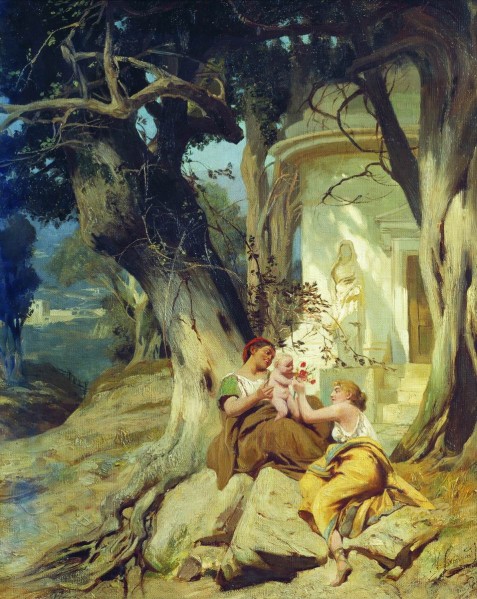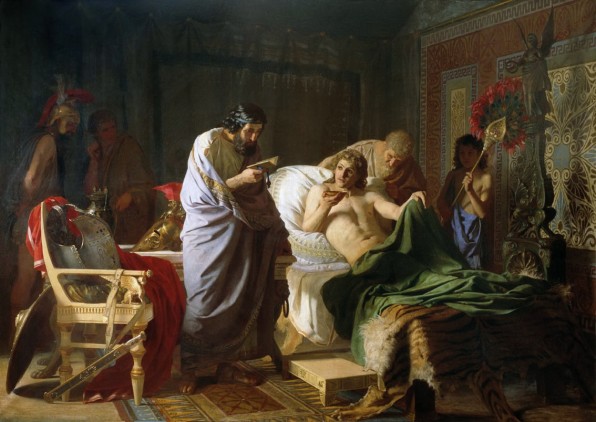Henryk Hector Siemiradzki / (1843-1902)
Henryk Hector Siemiradzki was born in October 24, 1843 into the family of Hippolit Siemiradzki, a Polish military officer in the service of the Russian Tzar. His childhood and youth were spent in Kharkov, then part of the Russian Empire, now the territory of Ukraine. Henryk received his first art lessons from the Ukrainian painter Dmitry Besperchy, a pupil of Karl Brulloff. Later Siemiradzki called him his only teacher. In 1860, under pressure from his family, he entered the Kharkov University. After graduating with a BA in science, he immediately left for St. Petersburg, where he got permission to visit lectures in the Academy of Arts; the Academy at that point did not accept students older than twenty. Very soon, however, the professors paid attention to the talented young man and he was admitted as a student, despite the age limits. During his very first year in the Academy, Siemiradzki received 2 silver medals, and later received awards every year (in all he got 6 silver and 3 gold medals). He impressed his classmates with his knowledge of science and ancient history. His teachers remarked that he was an excellent colorist and draftsman. In 1870, Siemiradzki got a Major Gold medal for his work Alexander the Great’s Trust in the Doctor Hippolitus and a pension to study abroad for 6 years.
First Siemiradzki went to Munich, at that time the second, after Paris, artistic center of Europe. He was confident enough to work independently, however he visited the studios of other masters, and especially often that of Carl Piloti, the famous historical painter. In Munich, Siemiradzki painted his first big work Roman Orgy in the Time of the Caesars (1872). The picture was bought by the St. Petersburg Academy, and the money helped the artist move to Italy. In Rome, where everything lives and breathes with art, he remained for the rest of his life, visiting Russia only from time to time.
The second big work by the painter Christ and Sinner. The First Meeting of Christ and Mary Magdalene. (1872), commissioned by the Grand Duke Vladimir Alexandrovich, the president of the Academy, brought Siemiradzki success and European fame. This painting presents the main peculiarities of his art: the effective composition in which the landscape plays the greatest role, helping unite the figures of people. In another painting Christ in the House of Martha and Mary. (1886) the landscape is of major importance, and his best biblical painting Christ and the Samaritan Woman. (1890) is practically a beautiful sunlit landscape, the figures of Christ and Samaritan playing an auxiliary role.
In 1876, Siemiradzki painted the big (3.85 x 7.04 m) painting Leading Light of Christianity. Nero’s Torches., a subject from Suetonius’ The Twelve Caesars. In the picture Emperor Nero and his courtiers watch how his servants set fire to Christian martyrs, bound with oakum and soaked with pitch. The work brought the artist the title of professor and Grand Prix at the World exhibition in Paris. He was accepted also into the Legion of Honour. Siemiradzki presented the painting to the city of Krakow.
In the 1870s, Siemiradzki, although he was a Catholic, got an important commission from the Holy Synod for murals in the Cathedral of Christ the Saviour in Moscow. About 40 leading Russian artists worked there, among them Vasily Surikov, Feodor Bruni, Peotr Basin, Ivan Kramskoy, Vasily Vereshchagin and many others. Siemiradzki longed for work of such importance and was enthusiastic about it. He painted a cycle of murals devoted to the life of Alexander Nevsky, and some episodes from the life of Christ. In 1931, the Communists blew up the Cathedral. All murals by outstanding artists, including Siemiradzki, were lost forever. We can get a vague idea of them from some remaining sketches.
St. Petersburg Academy granted Siemiradzki with titles and awards, he received large official commissions, his works represented the Russian art school at various world exhibitions. But the democratic critics took his art very negatively, noting the lack of psychological analysis and deep thought under the beautiful surface. Stasov was especially sharp, calling his paintings “glittering and noisy toys”, “immoral art, which bears neither educational nor progressive idea.”
In the 1890s Siemiradzki worked for the theater, he designed stage curtains for the Krakow and Lvov theaters, decorated the house of the Philharmonic Society in Warsaw.
Henryk Siemiradzki died in 1902 in his estate Strzalkowo, near Czestochowy in Poland, he was buried first in Warsaw, but in a year was re-buried in Krakow in the necropolis of the famous Poles.
Though Siemiradzki received his education in Russia, his art can’t be classified as any ‘national’ school. It is international. The painter himself is one of the best representatives of the late European Neoclassicism.






.jpg)





.jpg)











.jpg)



.jpg)















.jpg)

































.jpg)


.jpg)



.jpg)











.jpg)




.jpg)





.jpg)



ليست هناك تعليقات:
إرسال تعليق